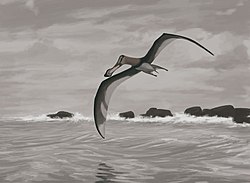
Back Pterosauria Afrikaans زاحف مجنح Arabic Pterosauria AST Pterozavr Azerbaijani Pterosauria BAN Птэразаўры BE-X-OLD Птерозаври Bulgarian Pterosaures Catalan Pterosauria CEB Ptakoještěři Czech
| Pterosaurs Temporal range: Upper Triassic – Upper Cretaceous
| |
|---|---|

| |
| Coloborhynchus piscator, an Upper Cretaceous pterosaur. | |
| Scientific classification | |
| Kingdom: | |
| Phylum: | |
| Class: | |
| (unranked): | |
| Order: | Pterosauria Kaup, 1834
|
| Suborders | |
Pterosaurs were flying reptiles which lived in the Mesozoic era at the same time as the dinosaurs.
Many pterosaurs were fairly small, but in the Upper Cretaceous some grew larger than any other flying animals. The pterosaur Quetzalcoatlus had a wing-span of up to 12 metres (~40 feet).
The first fossils occur in the Upper Triassic, and the group continued until the K/T extinction event at the end of the Cretaceous (220 to 65.5 million years ago).[1] Pterosaurs are the earliest vertebrates known to have evolved powered flight. Their wings were made from a flap of skin between their bodies and a big fourth finger (sometimes called the "wing finger"). The pterosaurs evolved into two groups. The earlier Rhamphorhynchoids (e.g. Rhamphorhynchus) had long tails and toothed jaws; The pterodactyloids (e.g. Pterodactylus) had short tails, and many had beaks with no teeth.
The first pterosaur fossil was discovered in the Late Jurassic Solnhofen limestone in Germany in 1784. This was exactly the same place as Archaeopteryx was found years later. Georges Cuvier first suggested that pterosaurs were flying creatures in 1801. Since the first pterosaur fossil was found, twenty-nine species of pterosaurs have been found in those deposits alone.
A famous early UK find was an example of Dimorphodon by Mary Anning, in 1828 at Lyme Regis, Dorset, England. The name Pterosauria was coined in 1834.[2][3]
Pterosaurs were genuine fliers, able to flap or soar. Their bodies were covered with fine hairs, so they were able to regulate their temperature (they were warm-blooded). They are a close sister-group to the dinosaurs, part of the Archosauria.
- ↑ Unwin, David M. 2006. The pterosaurs: from deep time. Pi Press, N.Y. ISBN 0131-46308-X
- ↑ Wellnhofer, Peter 1991. The illustrated encyclopedia of pterosaurs. London, Salamander. Reprinted as part 2 of The illustrated encyclopedia of dinosaurs. London, Salamander, 2000.
- ↑ Wellnhofer, Peter 1978. Pterosauria. Handbuch der Palaeoherpetologie, Teil 19. Stuttgart, Fischer.